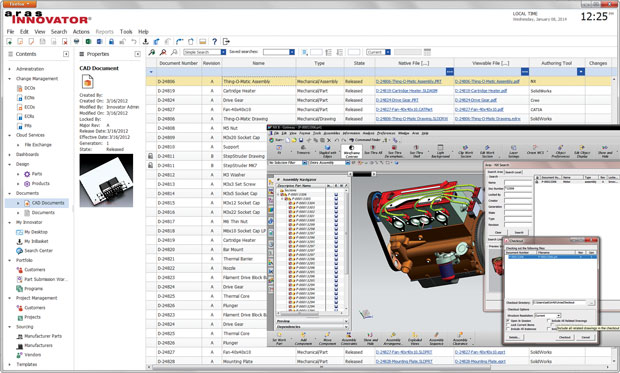
Aras Innovator® 11 provides extensive CAD integrations for CATIA, SolidWorks, Inventor, Creo, AutoCAD, NX, Solid Edge, ECAD and more.
Latest News
July 1, 2015
 The future is coming at design engineering teams fast. Increasingly complex, connected products must be designed, simulated, optimized, tested and deployed all within a short development cycle. Once deployed, many of those sensor-laden products will begin reporting back with all kinds of real-world use data that engineering teams can then analyze to further improve their designs.
The future is coming at design engineering teams fast. Increasingly complex, connected products must be designed, simulated, optimized, tested and deployed all within a short development cycle. Once deployed, many of those sensor-laden products will begin reporting back with all kinds of real-world use data that engineering teams can then analyze to further improve their designs.
The ability to continue to develop more innovative products in less time largely hinges on product lifecycle management. To support the fluidity of technology and business, PLM solutions need to be able to easily adapt to the shifting landscape without holding companies hostage or requiring them to start over from scratch.
Like enterprise resource planning (ERP) software and other major corporate systems, PLM can be one of the more costly and labor-intensive enterprise endeavors, in some cases taking years to deploy and costing millions of dollars. Organizations aren’t likely to jump at the chance to replace a PLM system once it’s up and running. More than likely, they will be tempted to make do with functionality limitations and stick with outdated business processes rather than go through the pain and expense of a full-scale migration to a next-generation PLM platform. In fact, according to a recent report by PLM industry analysts CIMdata, PLM systems are updated on average only every six years and, for a third, every 10 years.
Forewarned is Forearmed
A resilient PLM platform is the best way to avoid this scenario and future-proof your investment, creating a solid foundation that can evolve with the times. A resilient PLM solution provides the best chance of accommodating a 20-year-plus corporate time horizon where market conditions constantly change, product complexity continues to skyrocket and global competition further intensifies.
A resilient PLM solution never boxes a company out of the latest technologies, empowering organizations to readily switch browsers, adopt new databases, or upgrade to the latest operating system when it makes sense and any time it’s ready. Because resilient PLM isn’t platform specific, it can easily accommodate whatever comes down the pike with minimal disruption and without requiring any kind of clairvoyance about what lies ahead for emerging technologies or future business requirements.
Aras Innovator is a PLM system architected from the ground up with resiliency in mind.
 Aras Innovator® 11 provides extensive CAD integrations for CATIA, SolidWorks, Inventor, Creo, AutoCAD, NX, Solid Edge, ECAD and more.
Aras Innovator® 11 provides extensive CAD integrations for CATIA, SolidWorks, Inventor, Creo, AutoCAD, NX, Solid Edge, ECAD and more.“You need to be sure that whatever PLM software you choose today will work when you have more users and greater workloads,” notes Peter Schroer, Aras president. “You need to make sure you don’t get stuck because your PLM platform won’t grow as big as you need it to.”
For more information, download the free paper, Making the Case for Resilient PLM, produced by Desktop Engineering and sponsored by Aras.
Subscribe to our FREE magazine, FREE email newsletters or both!
Latest News
About the Author
DE’s editors contribute news and new product announcements to Digital Engineering.
Press releases may be sent to them via [email protected].







